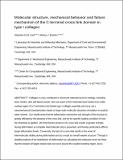Molecular structure, mechanical behavior and failure mechanism of the C-terminal cross-link domain in type I collagen
Author(s)
Uzel, Sebastien Guy Marcel; Buehler, Markus J
Downloadpaper_ACCEPTED.pdf (955.1Kb)
OPEN_ACCESS_POLICY
Open Access Policy
Creative Commons Attribution-Noncommercial-Share Alike
Terms of use
Metadata
Show full item recordAbstract
Collagen is a key constituent in structural materials found in biology, including bone, tendon, skin and blood vessels. Here we report a first molecular level model of an entire overlap region of a C-terminal cross-linked type I collagen assembly and carry out a nanomechanical characterization based on large-scale molecular dynamics simulation in explicit water solvent. Our results show that the deformation mechanism and strength of the structure are greatly affected by the presence of the cross-link, and by the specific loading condition of how the stretching is applied. We find that the presence of a cross-link results in greater strength during deformation as complete intermolecular slip is prevented, and thereby particularly affects larger deformation levels. Conversely, the lack of a cross-link results in the onset of intermolecular sliding during deformation and as a result an overall weaker structure is obtained. Through a detailed analysis of the distribution of deformation by calculating the molecular strain we show that the location of largest strains does not occur around the covalent bonding region, but is found in regions further away from this location. The insight developed from understanding collagenous materials from a fundamental molecular level upwards could play a role in advancing our understanding of physiological and disease states of connective tissues, and also enable the development of new scaffolding material for applications in regenerative medicine and biologically inspired materials.
Date issued
2011-02Department
Massachusetts Institute of Technology. Center for Computational Engineering; Massachusetts Institute of Technology. Department of Mechanical Engineering; Massachusetts Institute of Technology. Laboratory for Atomistic and Molecular MechanicsJournal
Journal of the Mechanical Behavior of Biomedical Materials
Publisher
Elsevier B.V.
Citation
Uzel, Sebastien G.M., and Markus J. Buehler. “Molecular Structure, Mechanical Behavior and Failure Mechanism Of the C-terminal Cross-link Domain In Type I Collagen.” Journal Of the Mechanical Behavior Of Biomedical Materials 4.2 (2011) : 153-161.
Version: Author's final manuscript
ISSN
1751-6161
1878-0180